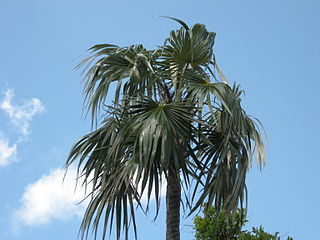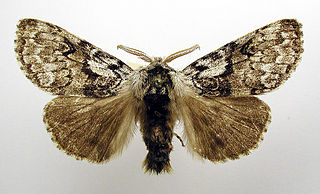
Callipielus is a genus of moths of the family Hepialidae. There are 10 described species, all found in southern South America.

Argiope argentata, commonly known as the silver argiope or silver garden spider due to the silvery color of its cephalothorax, is a member of the orb-weaver spider family Araneidae. This species resides in arid and warm environments in North America, Central America, the Caribbean and widely across South America. In the United States, it is found at least in Southern California, Florida, Arizona, and Texas. A. argentata create stabilimenta and a unique zig-zag in its web design, and it utilizes its UV-reflecting silk to attract pollinating species to prey upon. Like other species of Argiope, its venom is not harmful to humans; however, it can be employed to immobilize its prey. A. argentata engages in sexual cannibalism either mid- or post-copulation. One aspect of particular interest regarding this species is its extinction patterns, which notably have minimal correlation with its population size but rather occur sporadically for the species.

Coccothrinax argentata, commonly called the Florida silver palm, is a species of palm tree. It is native to south Florida, southeast Mexico, Colombia and to the West Indies, where it is found in the Bahamas, the southwest Caribbean and the Turks and Caicos Islands. Its natural habitat is rocky, calcareous soil in coastal scrubland and hammock communities.

The silvered bat is a species of vesper bat in the family Vespertilionidae. It is found in Angola, Burundi, Cameroon, Republic of the Congo, Democratic Republic of the Congo, Equatorial Guinea, Kenya, Malawi, Rwanda, and Tanzania. Its natural habitats are subtropical or tropical moist lowland forests and moist savanna.
The Damara woolly bat is a nocturnal insectivorous species of vesper bat in the family Vespertilionidae found in Africa. This species typically has reddish brown fur on its back and white fur on its abdomen. Its natural habitat is moist savanna, although it has also been shown to inhabit woodlands and coastal forests. These bats typically weight about 10 g, and have a low aspect ratio, as well as low wing loading.

Carcinopodia is a genus of moths in the subfamily Arctiinae. The genus was erected by George Hampson in 1900.

Lophocampa argentata, the silver-spotted tiger moth, is a species of moth in the family Erebidae. It was described by Packard in 1864. It is found from British Columbia to southern California, and east to Arizona, Nevada, New Mexico, Colorado, Utah, Wyoming and possibly to northern Mexico.
Provia argentata is the only species in the monotypic moth genus Provia of the family Noctuidae. It is found in the US state of Utah. Both the genus and species were first described by William Barnes and James Halliday McDunnough in 1910.

Pyroderces is a genus of cosmet moths. It belongs to subfamily Cosmopteriginae. Some authors include Anatrachyntis here.

Icaricia lupini, the lupine blue, is a butterfly of the family Lycaenidae. It is found from south-western Canada, south through much of mountainous and intermountain western United States and high plains to northern Mexico.

Calliteara abietis is a moth of the family Erebidae. It is found from northern and central Europe, through Russia to Japan.
Chrysocercops argentata is a moth of the family Gracillariidae. It is known from Pahang, Malaysia and from Nepal.
Micardia argentata is a species of moth of the family Noctuidae first described by Arthur Gardiner Butler in 1878. It is found in China, Korea and Japan.

Anaphosia astrigata is a moth of the subfamily Arctiinae. It was described by George Hampson in 1910. It is found in the Democratic Republic of the Congo, Tanzania and Zimbabwe.
Anaphosia aurantiaca is a moth of the subfamily Arctiinae. It was described by George Hampson in 1909. It is found in South Africa.

Carcinopodia furcifasciata is a moth of the subfamily Arctiinae. It is found in Malawi.
Carcinopodia schoutedeni is a moth of the subfamily Arctiinae. It is found in the Democratic Republic of Congo.
Paremonia argentata is a moth of the subfamily Arctiinae. It was described by George Hampson in 1914. It is found in Ghana and Kenya.
Langsdorfia is a genus of moths in the family Cossidae.
The Argentata dell'Etna is an Italian breed of domestic goat indigenous to the area of Mount Etna in the province of Catania and the Monti Peloritani in the province of Messina, in the Mediterranean island of Sicily, in southern Italy. It is raised mainly in that area, but also in the provinces of Enna and Palermo. It is named for the volcano and for its silvery grey coat. The origins of the breed are unknown; it shows similarities to the Garganica breed, and to other Italian grey breeds such as the Ciociara Grigia of Lazio and the Cilentana Grigia of Campania.









